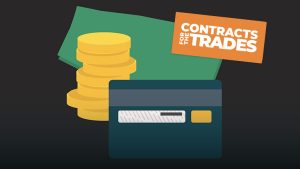How to Minimise the Risk of Card Payment Fraud
October 14, 2022 | Read: 8 minutes

For many businesses in field service industries, cash payments from customers made up a large percentage of sales.
However, cash sales are rapidly declining and card payment is on the rise.
Spurred on by the pandemic and technological advancements of contactless payment, the use of cash has dramatically fallen.
For field service businesses, the need to accept onsite digital payments via contactless options is now a necessity.
While technology and security protocols ensure that card fraud is rare, there are still some pitfalls to avoid. Precautions should be taken to minimise the risk of credit card payment fraud impacting your business.
This article describes what you need to know to avoid becoming a victim of credit card payment fraud.

Minimise the Risk of Credit Card Payment Fraud:
It is a fact of life that the moment your business begins to take card payments, it opens up the risk of becoming a victim of fraud. The only certain way to avoid all risks is to not accept card payments. In today’s world, this is no longer a viable option.
The first step toward minimising the risks that face your business is to understand the common types of risks that it is exposed to. These are listed below:
Friendly Fraud
Despite the name, there is nothing friendly about this type of fraud. The worrying thing about this type of fraud is that almost anyone can carry it out. This makes it difficult (but not impossible) to defend against.
This type of fraud occurs when the customer initially pays the merchant and subsequently contacts their card credit card company and lodges a dispute. Most often, they will cite one of the following reasons:
- The work carried out was not satisfactory
- Supplied goods were faulty or damaged
- Work not completed
- The service supplied was not as described
Once the customer has contacted the credit card company, their account is fully reimbursed, and the merchant does not receive the owed funds. This is one of the biggest challenges facing businesses as they are difficult to identify. Later in the article, we will list some steps that can minimise the risk of friendly fraud.
Wire Fraud
This type of fraud occurs when a customer overpays for an order (usually a large one). They then request that the merchant refunds the overpaid amount to the customer or to another party.

Once the overpaid amount is safely in the designated account, the fraudster will ensure the sale doesn’t go through. This leaves the merchant facing the loss of the refunded money.
This is more easily defended against when compared to friendly fraud. The defence against this fraud is mostly down to due diligence. Look out for patterns that include large orders from new customers and avoid refunding money in such circumstances. Advise the customer to initiate the refund from their end and avoid fulfilling the order until all payment issues are resolved.
Forced Authorisation Fraud
This type of fraud exploits a weakness in the payment system. However, it does rely on a proactive part being played by the merchant and as such, it is easily avoided.
The scam works like this – Authorisation codes are a legitimate method of forcing through payments that have otherwise been blocked. In normal circumstances, blocked payments are completed after the card issuer has provided an authorisation code. The problem lies in the fact that any random number can be typed into a payment terminal as an authorisation code and be accepted.
The above is the vulnerability that fraudsters exploit. A common scam is for a customer to attempt and fail to make a payment. These are usually larger payments that merchants can be overkeen to secure.
The customer then pretends to phone their bank. The bank then speaks to the merchant and provides them with a fake authorisation code. This pushes the payment through fraudulently.
Stopping this type of fraud is relatively simple – If a customer payment fails, then don’t accept an authorisation code, other steps to take are listed below:
- Try the card again – If the customer wants to contact their bank, then encourage them to do so, but refuse to accept any codes from any source. Instead, let the customer arrange with the bank for the card to be authorised and then try the transaction again
- Ask for a different form of payment – Many people carry multiple cards or contactless payment methods, politely decline the offer of an authorisation code and insist on another method
- Don’t allow the customer access to your card machine – Clever operators will know how to quickly authorise a payment if they are allowed access to your payment hardware
Stolen Cards (Identity theft)
While this type of fraud is one of the more prevalent forms of credit card fraud, for the field services sector, it is not of particular concern. A simple ID check is usually adequate protection against this type of fraud.

The nature of the field services sector is that services are usually carried out at a customer’s home or business address. This means that credit card payments made using stolen cards are unlikely.
In the first instance, the card name needs to match the customer’s, and the merchant is usually privy to this information.
Secondly, the fact that services are most commonly provided at fixed addresses exposes a level of risk to the fraudster that most are unlikely to accept.
Unlikely as it may be, vigilance is still essential. Look for unusually sized orders from new customers, particularly when there are no fixed addresses associated with the order.
Limit Exposure to Credit Card Payment Fraud
The most common type of fraud your field service business is likely to be exposed to is “Friendly Fraud.” This will be covered in more detail a little further down the page. For most of the others, it is a case of ensuring that due diligence is applied when accepting credit card payments.
One critical step in achieving this is to draw up a procedure that employees should follow when accepting card payments. This should include:
- How to spot the red flags that may indicate potentially fraudulent behaviour
- The steps to take if fraud is suspected
- All staff are aware of the common types of fraud
- Use a reputable card payment machine provider with full customer support
- Make sure that any sales software you use meets Strong Customer Authentication (SCA) Legislation
High-quality sales software that gives you all your customer’s details at your fingertips is also an incredibly useful tool in fraud prevention.
Four Quickfire Tips for Preventing Friendly Fraud
This is the number one challenge when it comes to fraud prevention, and it is difficult to completely eliminate the risk. However, there are a few guidelines that will minimise your exposure to it.
But, it is also important to recognise that the mechanism behind this fraud is designed to protect consumers, and rather than being a fraud, often, it is confusion on the customer’s part that initiates the refund procedure. This can be minimised by following a few steps.
- Consistent Trading Name – customers often request a chargeback if they don’t recognise the name of the company on their payment records
- Don’t oversell your services – Be honest with your customer about the service you supply and the expected outcome of the work you carry out
- Check that the sum being charged is correct – It can be easy to make mistakes that both the merchant and the customer initially miss. When the customer notices that £200 has been deducted from their card instead of £20, they will contact their card provider and request that the transaction is reversed
- Keep Complete Records of the Work Done – This is crucial should a customer make a complaint and requests a payback. For instance, workflow templates can allow the engineering field service industry can monitor each facet of every job
Final Thoughts on Preventing Payment Fraud
Unfortunately, where there is the potential to make money illegally, there is a portion of the population willing to take advantage of it.
While it is impossible to completely protect your business from the risk of credit card payment fraud, a few simple procedures introduced at a company-wide level can greatly reduce your risk.
Field service management software with built-in security options is one great way to mitigate risk
Ultimately, much of the risk you face can be reduced simply by using software and payment systems providers. Together, take security seriously and have a strong focus on always improving customer service.
If you enjoyed this post, consider subscribing to get access to regular updates, news, resources, and more!

Join our mailing list
Subscribe to our newsletter and we’ll send you regular updates straight to your inbox!











